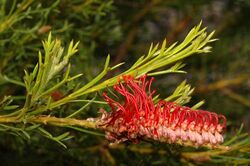Biology:Grevillea fastigiata
| Grevillea fastigiata | |
|---|---|

| |
| Scientific classification | |
| Kingdom: | Plantae |
| Clade: | Tracheophytes |
| Clade: | Angiosperms |
| Clade: | Eudicots |
| Order: | Proteales |
| Family: | Proteaceae |
| Genus: | Grevillea |
| Species: | G. fastigiata
|
| Binomial name | |
| Grevillea fastigiata Olde & Marriott[3]
| |
Grevillea fastigiata is a species of flowering plant in the family Proteaceae and is endemic to the south-west of Western Australia. It is an erect shrub with clustered branches, linear leaves sometimes with rigid lobes near the tip, and clusters of brownish or scarlet flowers.
Description
Grevillea fastigiata is an erect shrub, typically 2.0–2.5 m (6 ft 7 in–8 ft 2 in) high with clustered branches. The leaves are linear, 18–45 mm (0.71–1.77 in) long, sometimes with three to seven rigid, sharply-pointed, linear lobes 5–20 mm (0.20–0.79 in) long and 0.8–1.2 mm (0.031–0.047 in) long near the ends. The edges of the leaves are rolled under, obscuring most of the lower surface. The flowers are erect in toothbrush-like clusters along a rachis 45–80 mm (1.8–3.1 in) long. The flowers are pale brown to scarlet with an orange-red to scarlet style and the pistil is 19–22 mm (0.75–0.87 in) long. Flowering occurs from September to March and the fruit is a follicle about 10 mm (0.39 in) long.[4][2]
Taxonomy
Grevillea fastigiata was first formally described in 1994 by Peter M. Olde and Neil R. Marriott in The Grevillea Book from specimens collected by Olde east of Ravensthorpe.[5] The specific epithet (fastigiata) means "fastigiate", referring to the branchlets.[6]
Distribution and habitat
This grevillea grows in mallee heath or shrubland in the upper catchment of the Jerdacuttup River in the Esperance Plains and Mallee biogeographic regions of south-western Western Australia.[4][2]
Conservation status
Grevillea fastigiata is listed as Endangered on the IUCN Red List of Threatened Species. This grevillea has a severely restricted distribution, as it occurs in a single area with an estimated extent of occurrence of 260km². Its population size and the extent and quality of its habitat are in decline due to threats associated with mining, such as land clearing and associated infrastructure.[1]
It is also listed as "Priority Four" by the Government of Western Australia Department of Biodiversity, Conservation and Attractions,[2] meaning that it is rare or near threatened.[7]
References
- ↑ Jump up to: 1.0 1.1 Monks, L.; Keighery, G. (2020). "Grevillea fastigiata". IUCN Red List of Threatened Species 2020: e.T113017730A113307996. doi:10.2305/IUCN.UK.2020-2.RLTS.T113017730A113307996.en. https://www.iucnredlist.org/species/113017730/113307996. Retrieved 6 January 2024.
- ↑ Jump up to: 2.0 2.1 2.2 2.3 "Grevillea fastigiata". FloraBase. Western Australian Government Department of Parks and Wildlife. https://florabase.dpaw.wa.gov.au/browse/profile/15840.
- ↑ "Grevillea fastigiata". Australian Plant Census. https://biodiversity.org.au/nsl/services/apc-format/display/83529.
- ↑ Jump up to: 4.0 4.1 "Grevillea fastigiata". Australian Biological Resources Study, Department of Agriculture, Water and the Environment: Canberra. https://profiles.ala.org.au/opus/foa/profile/Grevillea%20fastigiata.
- ↑ "Grevillea fastigiata". APNI. https://id.biodiversity.org.au/instance/apni/559556.
- ↑ "Grevillea fastigiata". APNI. https://id.biodiversity.org.au/instance/apni/51356703.
- ↑ "Conservation codes for Western Australian Flora and Fauna". Government of Western Australia Department of Parks and Wildlife. https://www.dpaw.wa.gov.au/images/documents/plants-animals/threatened-species/Listings/Conservation%20code%20definitions.pdf. Retrieved 21 April 2022.
Wikidata ☰ Q5607917 entry
 |



